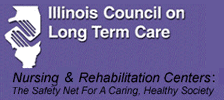|

FOR IMMEDIATE RELEASE
February 28, 2002
Code
Blue for Medicaid: Illinois Nursing Home Residents
at Risk
Proposed Medicaid
Cuts Will Lead to Many Nursing Homes Going Bankrupt
(CHICAGO)
-- The Illinois Council on
Long Term Care predicts that many nursing facilities
will have to close their doors if Governor Ryan's
proposed budget for Medicaid is passed. This threatens
the status of the more than 50,000 Illinois residents on
Medicaid in Illinois nursing homes, constituting almost
two-thirds of the state's total nursing home population.
The Governor's proposed budget includes an 8.8% cut
to Medicaid funding to Illinois nursing homes, totaling
$171 million, along with a complete elimination of
bedhold payments in Medicaid. Bedhold payments are
monies paid to nursing facilities to hold a bed for a
resident while this person is at the hospital.
If the proposed Medicaid cuts go through, the state
will needlessly lose federal funds in the process. A
$171 million cut will lead to $85.5 million in federal
matching funds being lost. Illinois will end up losing
50 cents of federal funds for every dollar decreased for
nursing home payments.
These proposed cuts come at a time when Illinois
already lags behind the national standard for Medicaid
funding for nursing homes. Currently, the average
Medicaid rate paid to Illinois nursing homes ranks 46th
in the nation. Average costs at Illinois nursing homes
have increased 51 percent over the last eight years,
while the Medicaid rates paid to these facilities have
increased only 29 percent.
"As 79 percent of a nursing home’s budget goes
to payroll, cuts in Medicaid reimbursement will make it
virtually impossible for nursing facilities to attract
and retain quality staff members in today’s highly
competitive labor market," said Terrence Sullivan,
executive director of the Illinois Council on Long Term
Care. "Thousands of nursing home staff members at
Illinois nursing homes will end up losing their jobs as
a result of these cuts to Medicaid, and resident care
will suffer as a result."
According to the Illinois Council on Long Term Care,
one solution to avoiding these devastating cuts to
Medicaid is to increase the provider license assessment.
By raising money through a provider license assessment,
all monies raised will be matched by the federal
government. Increasing the provider license assessment
will cost the state nothing and will generate the
necessary funds to provide
quality care to our state's elderly. Rather than lose
federal funds, a license assessment brings more federal
funds to Illinois to help solve the state's budget
problems.
"The State of Illinois has the moral obligation
to maintain the safety net of long term care facilities
for some of the state’s most frail and vulnerable
citizens," adds Sullivan. "Our society
has the responsibility of properly caring for those who
cared for us. The proposed 8.8% cut to Medicaid funding
poses a terrible threat to the health, independence, and
well-being of the more than 50,000 Illinois nursing home
residents dependent on Medicaid. Increasing the provider
license assessment is the most practical solution to
maintaining the safety net of long term care for our
state's elderly citizens."
An additional burden looms with the return of a
Medicaid reimbursement methodology that has not been
used since 1994, called the DPA 2700 Inspection of Care
(IOC) system. The state is bringing back this
reimbursement system for the sole purpose of cutting
Medicaid rates, resulting in countless hours of staff
time for completing unnecessary paperwork, in addition
to the lost federal dollars.
"The combined effect of all of these measures
will be absolutely devastating for nursing home
residents and the Illinois nursing home
profession," states Sullivan. "With two-thirds
of our state’s nursing home population dependent on
Medicaid, it is crucial that the State provides adequate
funding to meet their health care needs."
# # #
The Illinois Council on Long Term Care is an
association of nursing home professionals representing
220 facilities employing 26,000 staff members who serve
over 38,000 residents. More information on long-term
care issues can be found at the Council’s web site
www.nursinghome.org .
|

